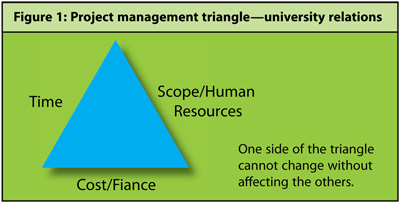NACE Journal, May 2013
Learn strategies for developing a solid university relations program on a budget.
A common mistake many companies make when building a university recruiting (UR) program is to focus on identifying core schools first. While this is a critical task, it’s not one of the first steps to tackle, especially if you need to build a university recruiting program when funds are low. Many companies have tightened their belts in recent years, so UR professionals must be creative with limited resources and human capital; it’s all about delivering more with less. As such, your first order of business should be to look inside instead of outward.
Consider these assessments so that you can build a firm understanding of your demand:
- Identify talent gaps in critical functions and businesses,
- Determine if university hires can help minimize these talent gaps,
- Categorize geographical locations with early career hire needs,
- Identify sponsors in key business and geographical units to champion your program, and most importantly,
- Determine if there is funding to pay for the hires as well as the UR program activities.
Building a Case for Hiring Early Career Talent
Funding for university recruiting is quite often the 800-pound gorilla in the room. Prior to starting campus recruiting, it’s essential that you have firm financial commitments. This can be a difficult task given the economic challenges in business and the cautious financial outlooks that many companies have adopted.
If you’re in HR/staffing and looking to secure “a seat at the table” in your company, you must be proactive in creating interest and buzz around your organization’s need for university hires. You can do this by partnering with business leaders and developing businesses cases to demonstrate potential return on investment (ROI). As part of your business case, you should highlight how university recruiting can be used as a talent lever. It is essential to creating a talent pipeline for tomorrow’s leaders.
University recruiting can also be a cost-effective alternative to high turnover. Case in point: if a company offers to pay a $60,000 starting salary for a recent mechanical engineering bachelor’s graduate, and we assume a conservative 3 percent annual pay increase, the compounded salary in five years will be approximately $72,000. Compare this to hiring someone with five years of experience, for whom the firm would likely have to pay an average starting salary of $85,000, along with a recruiters’ fee, which are often more costly than campus recruiting costs. To win over your organization’s business leaders, you need to convince them of the potential savings per hire. These savings can be very attractive in an environment where head counts are tough to come by and budgets are tight.
More Hires = Lower Costs
To further lower your operational cost, leverage a basic economic principle: economies of scale. The cost of attending a career fair or corporate presentation is fixed, whether five or 50 students are attending. The more students you can hire from a school, the lower your cost-per-hire will be. It is critical to have a holistic demand forecast in place before beginning the core school selection process. Ideally, you want to select schools that are strong in the functions or majors you are hiring in, with students who can move to the geographic locations of your choice. Your goal is to invest in a minimum number of schools that will allow you to fill as many of your openings with the highest-possible caliber of talent.
UR Is About Operational Excellence
What makes UR an exciting field is that doing the work helps the UR professional to be strong in many fundamental areas, including project management and process improvement. This is particularly the case if your objective is to run a cost-effective university relations program.
A strong project manager needs to balance the three sides of a project management triangle, which are cost, time, and scope. (See Figure 1.) Since the campus recruiting cycle is compressed and can be intense, a UR team must be sensitive to leveraging its resources to do the work within tight time constraints. UR is more than just about attending campus events. There are many behind-the-scenes tasks that are not so glamorous—such as preparing for a campus event and screening resumes after the campus visit. To meet the company’s recruiting goals with the allotted resources, UR professionals must plan ahead and carefully consider where to best use resources to get the highest possible return for effort. Keep in mind that there will be times when you will need to decline an executive’s alma mater invitation for a corporate visit if that school is not in the target geographical location or does not have the desired field(s) of study.

Along with strong project management skills, UR professionals must have the discipline to track performance and the ability to eliminate non-value-added work. For example, for each campus event at a school, whether it is a career fair or a corporate presentation, you should collect metrics to help you assess which event had a stronger return. Be sure to consider the following:
- How many resumes did you collect as a result of a particular event?
- How many of those resumes made it to the first round, second round, and offer stage?
- What is the cost-per-hire-per-event?
When you tally your results, you’ll likely be amazed at how your memory or impression can play tricks on you. A very busy career fair may not net many successful resumes because traffic came from students who are not good matches to your organization’s openings. Keeping track of accurate data requires a lot of discipline and awareness, but numbers don’t lie. Metrics will provide the perspective to help you understand the changes that will make your UR program even more cost-efficient while also meeting your talent acquisition goals faster.
Building an effective university relations program on a dime requires not only coordinated work force planning and support from the company’s business leaders, but strong project management and continuous improvement approaches. To accomplish this successfully, you’ll also need to ramp up your organizational alignment and collaboration. Partnering with schools and meeting new talent is the easy part; to run a truly impactful program, your challenge will be to get your own house in order first.
Copyright 2013 by the National Association of Colleges and Employers. All rights reserved.






